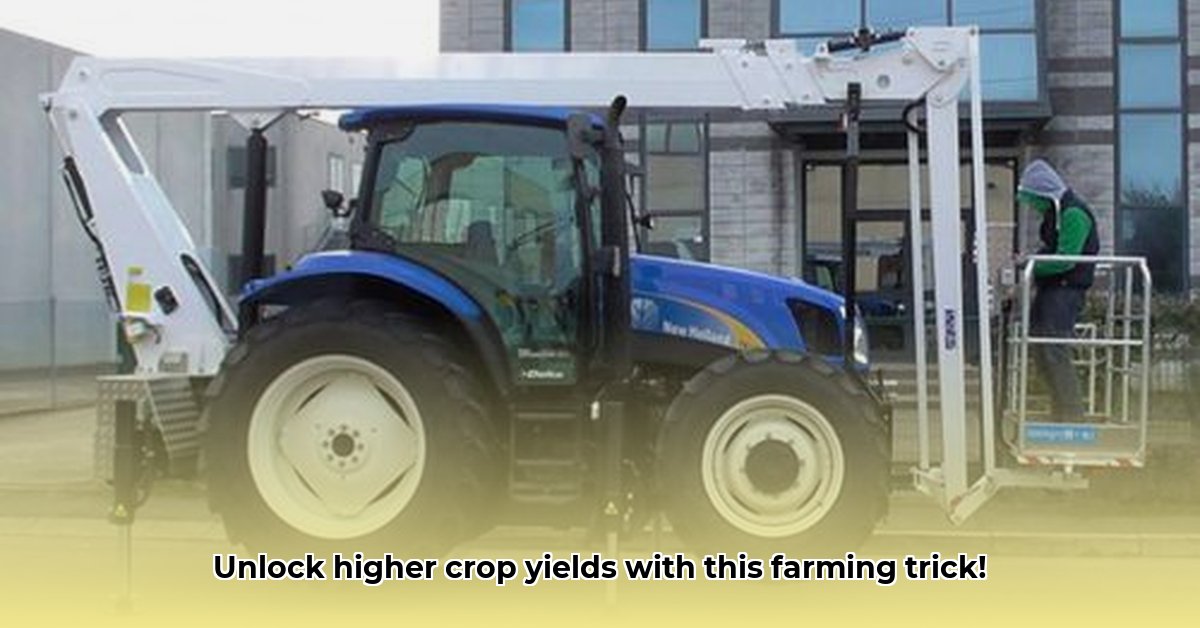
Understanding Boom Lift Technology: Precision Farming for a Healthier Planet
Boom lifts for tractors are revolutionizing sustainable agriculture. These versatile attachments allow for precise application of fertilizers, pesticides, and other treatments, minimizing waste and maximizing efficiency. But how do they work, and which type is right for your farm? For larger-scale land preparation, see land clearing techniques.
Types of Boom Lifts: Tailoring Precision to Your Needs
Several types of boom lifts cater to different farming needs and terrains:
Telescopic Booms: These extend and retract, providing flexibility in reaching various areas. (Think of them as adjustable arms that can lengthen and shorten to reach different heights and distances.)
Articulated Booms: Highly maneuverable, articulated booms bend at joints, ideal for navigating tight spaces between rows. (Perfect for orchards or closely planted crops.)
Vertical Booms: Designed for pinpoint vertical accuracy, these are suited for tall crops or treatments requiring precise vertical placement. (Excellent for targeted applications on taller plants.)
Choosing the right boom lift depends on factors such as farm size, crop types, terrain, and specific application needs. "The ideal boom lift is the one that best suits your specific operational requirements," explains Dr. Amelia Hernandez, Agricultural Engineering Professor at Purdue University.
Safe Operation and Maintenance: Prioritizing Safety and Longevity
Safe operation is paramount. Always consult your equipment's manual before use. Follow these key steps:
- Pre-flight Check: Inspect for damage, loose parts, and correct fluid levels.
- Level Ground: Ensure stable, level positioning of the tractor before raising the boom.
- Secure Attachments: Verify all attachments are firmly fixed.
- Test Run: Perform a test run to confirm functionality and familiarize yourself with controls.
- Regular Maintenance: Clean, lubricate, and inspect the boom lift regularly to maintain optimal performance and prevent breakdowns. "Regular maintenance is not just a good practice; it's an investment in the long-term sustainability of your operation," says John Miller, Farm Manager at Miller Family Farms.
Neglecting maintenance can lead to costly repairs and safety hazards. Remember, a well-maintained boom lift is an efficient and safe boom lift.
Precision Application Techniques: Maximizing Efficiency and Minimizing Environmental Impact
Boom lifts enable precision farming practices with significant environmental benefits.
Targeted Fertilizer Application: Optimizing Nutrient Delivery
Precise fertilizer application ensures plants receive optimal nutrients, reducing waste and minimizing runoff into waterways. This process reduces fertilizer costs and minimizes environmental damage. "Targeted application can lead to substantial savings on fertilizer expenses," notes Sarah Chen, Sustainability Consultant at GreenTech Solutions.
Precise Pesticide Spraying: Reducing Drift and Protecting Beneficial Insects
Targeted spraying minimizes pesticide drift, protecting beneficial insects and reducing environmental contamination. This approach contributes to a healthier ecosystem and reduces the overall amount of pesticide use. A key consideration for sustainable agriculture lies in efficient resource management such as minimizing pesticide drift.
Key Tips for Successful Application:
- Calibration: Accurate calibration is crucial for applying the correct treatment amount.
- Wind Conditions: Avoid spraying in windy conditions to reduce drift.
- Label Adherence: Always follow fertilizer and pesticide label instructions.
These practices ensure you're getting the most out of your boom lift while minimizing negative environmental consequences.
Environmental Considerations and Cost-Benefit Analysis: Investing in a Sustainable Future
Boom lifts offer significant environmental advantages, but responsible usage is key.
Weighing the Pros and Cons: A Balanced Perspective
| Pros | Cons |
|---|---|
| Lower chemical usage | Potential for drift if improperly operated |
| Improved precision and efficiency | Requires initial investment and regular maintenance |
| Reduced environmental impact | May not be suitable for all terrains and crop types |
| Targeted fertilizer application | Operator training and skill are essential |
| Labor savings | Requires adherence to strict safety regulations |
Understanding these factors facilitates informed decision-making.
The Financial Landscape: ROI and Long-Term Savings
While boom lifts require an upfront investment, the long-term cost savings are substantial. Reduced chemical and labor costs, along with increased yields, can quickly offset the initial investment. A thorough cost-benefit analysis should consider all factors before purchasing. "The long-term ROI on boom lift technology can be significant for farms committed to sustainable practices," emphasizes Dr. David Lee, Agricultural Economist at the University of Illinois.
Case Studies and Future Trends: A Glimpse into the Future of Sustainable Farming
Several farms have successfully integrated boom lifts into their sustainable practices achieving significantly improved efficiency and reduced environmental impact. Ongoing research aims to further refine boom lift technology, leading to even more precise and automated systems. The future of sustainable agriculture incorporates advanced technologies like boom lifts for maximized efficiency and minimized environmental impact.
Key Takeaways:
- Boom lifts contribute to sustainable agriculture through precise application of treatments.
- Careful selection, safe operation, and regular maintenance are crucial for efficiency and safety.
- Consider the environmental implications and conduct a cost-benefit analysis before investing.
This comprehensive guide equips farmers with the knowledge to harness the power of boom lifts for enhanced yields and sustainable farming practices. Further research into specific boom lift models and their applications will provide more in-depth information relevant to individual farms.